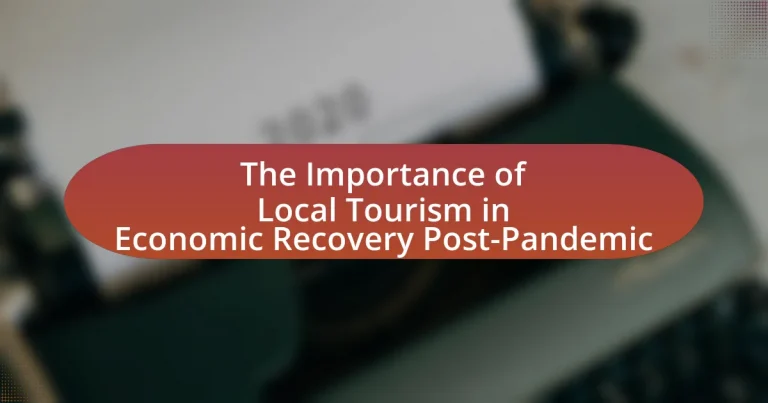Local tourism plays a vital role in economic recovery following the pandemic by stimulating local economies, creating jobs, and enhancing community resilience. It generates revenue for small businesses, supports employment in various sectors, and contributes to increased tax revenues. The article examines how local tourism fosters community identity, addresses challenges faced in the post-pandemic era, and outlines effective strategies for promoting local tourism. Additionally, it highlights the importance of collaboration among stakeholders and individual contributions to bolster local tourism efforts, ultimately aiding in the revitalization of affected communities.

What is the Importance of Local Tourism in Economic Recovery Post-Pandemic?
Local tourism is crucial for economic recovery post-pandemic as it stimulates local economies, creates jobs, and fosters community resilience. By encouraging residents to explore nearby attractions, local tourism generates revenue for small businesses, such as restaurants and shops, which have been significantly impacted by the pandemic. According to a report from the U.S. Travel Association, domestic travel spending is projected to recover faster than international travel, highlighting the importance of local tourism in revitalizing economic activity. Additionally, local tourism helps to rebuild consumer confidence and encourages safe travel practices, further supporting the recovery of the hospitality and service sectors.
How does local tourism contribute to economic recovery?
Local tourism significantly contributes to economic recovery by stimulating local economies through increased spending on services and goods. When residents and visitors engage in local tourism activities, they support businesses such as restaurants, hotels, and attractions, which in turn creates jobs and generates tax revenue. For instance, a study by the U.S. Travel Association found that domestic travel spending in the United States reached $792 billion in 2021, highlighting the substantial economic impact of local tourism. This influx of spending helps to revitalize communities, particularly in areas heavily affected by economic downturns, such as those caused by the pandemic.
What are the key economic indicators affected by local tourism?
Key economic indicators affected by local tourism include employment rates, local business revenues, tax revenues, and infrastructure investment. Employment rates typically rise as tourism creates jobs in hospitality, retail, and service sectors; for instance, a study by the World Travel & Tourism Council found that tourism supported 330 million jobs globally in 2019. Local business revenues increase as tourists spend on accommodations, dining, and attractions, contributing to the overall economic activity in the area. Tax revenues also benefit, as increased spending leads to higher sales tax collections, which can fund public services. Additionally, local governments may invest in infrastructure improvements, such as transportation and public spaces, to enhance the tourist experience, further stimulating economic growth.
How does local tourism support small businesses in communities?
Local tourism supports small businesses in communities by increasing foot traffic and customer engagement, which directly boosts sales and revenue. When tourists visit a community, they often seek local dining, shopping, and entertainment options, leading to higher patronage of small businesses. According to the U.S. Travel Association, domestic travelers spent $972 billion in 2019, with a significant portion directed towards local establishments. This influx of spending helps small businesses recover from economic downturns, particularly following the pandemic, as they rely heavily on local and tourist patronage for sustainability and growth.
Why is local tourism essential for community resilience?
Local tourism is essential for community resilience because it stimulates economic activity, fosters social cohesion, and supports local businesses. By encouraging residents to explore and engage with their own communities, local tourism generates revenue that can be reinvested into public services and infrastructure. For instance, a study by the World Travel & Tourism Council found that in 2021, local tourism contributed significantly to job creation and economic recovery in regions heavily impacted by the pandemic, with a 30% increase in local spending in areas that promoted domestic travel. This economic boost enhances the community’s ability to withstand future crises, making local tourism a vital component of resilience strategies.
What role does local tourism play in job creation?
Local tourism significantly contributes to job creation by generating employment opportunities in various sectors such as hospitality, retail, and transportation. According to the World Travel & Tourism Council, in 2019, the travel and tourism sector supported 330 million jobs globally, which accounted for 10.3% of total employment. This sector’s recovery post-pandemic is crucial, as local tourism stimulates demand for services, leading to the hiring of staff in hotels, restaurants, and attractions. Furthermore, local tourism encourages small business growth, which often results in additional job openings within communities.
How does local tourism enhance community identity and pride?
Local tourism enhances community identity and pride by fostering a sense of belonging and connection among residents. When local attractions, culture, and history are showcased to visitors, community members often feel a renewed appreciation for their heritage and environment. For instance, studies have shown that communities with active tourism initiatives report higher levels of civic engagement and local pride, as residents take ownership of their cultural assets. This is evidenced by the National Endowment for the Arts, which found that local arts and cultural events, often supported by tourism, significantly contribute to community cohesion and identity.
What challenges does local tourism face in the post-pandemic era?
Local tourism faces several challenges in the post-pandemic era, including reduced consumer confidence, changing travel preferences, and economic constraints. Reduced consumer confidence stems from lingering health concerns, as many travelers remain cautious about crowded places and potential outbreaks. Changing travel preferences have shifted towards more remote and nature-based destinations, impacting traditional tourist hotspots. Economic constraints are evident as many local businesses struggle with financial recovery, leading to limited resources for marketing and service improvements. According to a survey by the World Travel and Tourism Council, 61% of travelers expressed hesitance to return to pre-pandemic travel habits, highlighting the ongoing impact of the pandemic on tourism behavior.
How have travel restrictions impacted local tourism initiatives?
Travel restrictions have significantly hindered local tourism initiatives by limiting the influx of visitors and reducing revenue streams for local businesses. For instance, during the COVID-19 pandemic, many regions experienced a dramatic decline in tourist arrivals, with global international tourist arrivals dropping by 74% in 2020 according to the United Nations World Tourism Organization. This decline forced local tourism initiatives to pivot towards domestic tourism strategies, often resulting in reduced marketing budgets and fewer resources for community engagement. Consequently, local businesses reliant on tourism faced closures and layoffs, further exacerbating economic challenges in those areas.
What strategies can local tourism adopt to overcome these challenges?
Local tourism can adopt strategies such as enhancing digital marketing, diversifying offerings, and fostering community partnerships to overcome challenges. Enhancing digital marketing allows local tourism to reach a broader audience, as evidenced by a 2021 study showing that 70% of travelers use social media for travel inspiration. Diversifying offerings, such as creating unique local experiences or promoting outdoor activities, can attract different demographics and increase visitor numbers. Additionally, fostering community partnerships can strengthen local economies; for instance, collaboration with local businesses can create package deals that benefit both tourists and residents, as demonstrated by successful initiatives in various regions post-pandemic.
How can local tourism be promoted effectively?
Local tourism can be effectively promoted by leveraging digital marketing strategies, community engagement, and partnerships with local businesses. Digital marketing, including social media campaigns and targeted online advertisements, can reach potential visitors and showcase local attractions, events, and experiences. Community engagement fosters a sense of pride and encourages residents to promote their area, while partnerships with local businesses can create attractive packages and experiences that draw tourists. According to a report by the World Travel & Tourism Council, local tourism initiatives can significantly boost economic recovery, with a focus on supporting small businesses and creating jobs in the community.
What marketing strategies are most effective for local tourism?
Effective marketing strategies for local tourism include targeted social media campaigns, partnerships with local businesses, and community engagement initiatives. Targeted social media campaigns leverage platforms like Instagram and Facebook to showcase local attractions and experiences, reaching potential visitors directly. Research indicates that 79% of travelers use social media for travel inspiration, highlighting its effectiveness. Partnerships with local businesses, such as hotels and restaurants, create package deals that enhance visitor experiences and encourage spending within the community. Additionally, community engagement initiatives, such as local events and festivals, foster a sense of belonging and attract both residents and tourists, contributing to economic recovery. These strategies collectively enhance visibility, drive foot traffic, and stimulate local economies post-pandemic.
How can community engagement enhance local tourism efforts?
Community engagement can enhance local tourism efforts by fostering a sense of ownership and pride among residents, which leads to more authentic and personalized visitor experiences. When community members actively participate in tourism initiatives, they can share their unique cultural heritage, local stories, and traditions, making the destination more appealing to tourists. For instance, a study by the World Tourism Organization found that destinations with strong community involvement see a 20% increase in visitor satisfaction, as tourists appreciate the genuine interactions and local insights. This engagement not only boosts the local economy through increased visitor spending but also encourages sustainable practices that benefit both the community and the environment.
What are the best practices for supporting local tourism in recovery?
To support local tourism in recovery, communities should prioritize collaboration among stakeholders, promote local attractions, and enhance visitor safety measures. Collaborative efforts, such as partnerships between local businesses, government, and tourism boards, can create cohesive marketing strategies that attract visitors. For instance, a study by the World Travel & Tourism Council indicates that regions with strong stakeholder collaboration saw a 20% faster recovery in tourism revenue post-pandemic. Additionally, promoting unique local experiences and attractions can draw visitors who seek authentic experiences, thereby boosting local economies. Implementing robust health and safety protocols reassures travelers, as evidenced by a survey from the American Hotel and Lodging Association, which found that 81% of travelers prioritize safety measures when choosing destinations. These best practices collectively foster a resilient local tourism sector during recovery.
How can local governments facilitate tourism recovery?
Local governments can facilitate tourism recovery by implementing targeted financial support programs for local businesses and promoting safe travel initiatives. For instance, providing grants or low-interest loans to tourism-dependent businesses can help them recover from pandemic-related losses, as evidenced by the $10 billion allocated by the U.S. government through the Paycheck Protection Program, which supported over 1.8 million jobs in the hospitality sector. Additionally, local governments can enhance marketing campaigns that highlight safety measures and local attractions, which can increase visitor confidence and drive tourism. Research from the World Travel & Tourism Council indicates that effective communication of health protocols can lead to a 20% increase in traveler willingness to visit destinations.
What partnerships are beneficial for boosting local tourism?
Collaborations between local businesses, government entities, and tourism organizations are beneficial for boosting local tourism. These partnerships create comprehensive marketing strategies, enhance visitor experiences, and streamline resources. For instance, joint promotions between hotels and restaurants can attract more visitors, while local governments can support tourism through infrastructure improvements and funding for events. According to a study by the World Travel & Tourism Council, regions that foster partnerships between stakeholders see a 20% increase in tourism revenue, demonstrating the effectiveness of collaborative efforts in revitalizing local economies post-pandemic.
What practical steps can individuals take to support local tourism?
Individuals can support local tourism by actively engaging in community-based activities and choosing local businesses for their travel needs. By visiting local attractions, dining at nearby restaurants, and staying in local accommodations, individuals contribute directly to the economic recovery of their communities. According to a report by the U.S. Travel Association, every dollar spent in local tourism generates approximately $3 in economic impact, highlighting the significance of individual contributions to local economies. Additionally, promoting local events and sharing experiences on social media can further enhance visibility and attract more visitors, thereby fostering a sustainable tourism environment.




